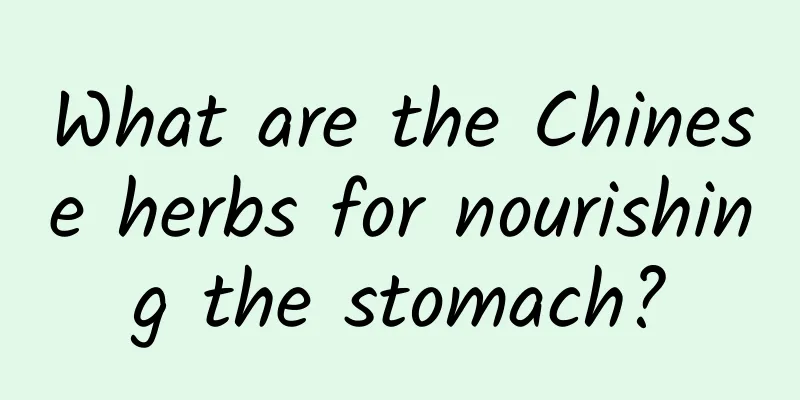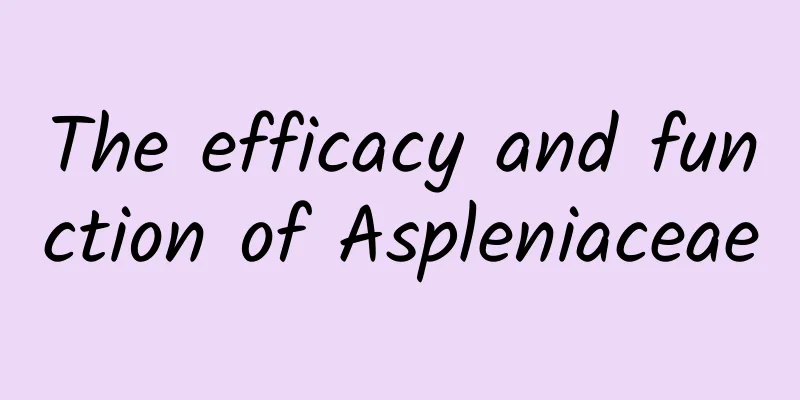What are the Chinese herbs for nourishing the stomach?

|
When it comes to the topic of Chinese medicine nourishing the stomach, I guess not many people know about it. As we all know, all medicines are poisonous to some extent. Chinese medicine cannot be taken randomly. It must be taken according to the symptoms to avoid harming yourself. But what specific Chinese medicinal herbs should we take to nourish our stomach? Below, we will briefly introduce several medicinal materials to you based on the information we have collected. 1. Atractylodes macrocephala Atractylodes is warm in nature, bitter and sweet in taste, and enters the spleen and stomach meridians. It has the effects of tonifying the spleen, benefiting the stomach, drying dampness, and harmonizing the middle. It is used to treat weak spleen and stomach qi, loss of appetite, fatigue and shortness of breath, bloating, diarrhea, phlegm, edema, jaundice, dampness, difficulty urinating, dizziness, spontaneous sweating, etc. It is a commonly used Chinese medicinal material. There are some products on the market that use the roots of Chrysanthemum notoginseng to impersonate Atractylodes macrocephala. Be careful to identify them when using them. 2. Yam Eating yam can strengthen the spleen and stomach, aid digestion, and is helpful for treating symptoms such as weak spleen and stomach, poor appetite, fatigue, and diarrhea. There are also some requirements for selecting yam. Generally, you should choose yams that are complete, straight, uniform in thickness, without abnormal spots, and not rotten. 3. Polygonatum Polygonatum has the effect of strengthening the spleen and replenishing qi, and is also suitable for people with weak spleen and stomach. If you are tired, weak, and have poor appetite, you can mix Polygonatum with Codonopsis pilosula, Atractylodes macrocephala, etc. to make a medicinal diet. If you are a person with stomach yin deficiency accompanied by dry mouth, loss of appetite, red tongue without coating, etc., you can mix Polygonatum with Dendrobium, Ophiopogon japonicus, Chinese yam, etc. to make a medicinal diet. 4. Lotus seeds Lotus seeds have a mild medicinal property and a slightly sweet taste. Traditional Chinese medicine believes that lotus seeds can replenish the spleen and stomach qi, have an antidiarrheal effect, and also have the effect of nourishing the heart and calming the nerves. It should be noted that the lotus seeds need to be cored before consumption. 5. Jujube Many Chinese medicine books have records about the health benefits of red dates: tonifying deficiency and replenishing Qi, nourishing blood and calming the mind, strengthening the spleen and stomach. It is a good health care product for patients with weak spleen and stomach, loss of appetite, loose stools, palpitations and fatigue, insufficient Qi and blood, fatigue and weakness, and insomnia. Drinking tea made from frying red dates until they turn black can treat stomach cold and stomach pain. 6. Licorice In traditional Chinese medicine, licorice nourishes the spleen and replenishes qi, relieves coughs and moistens the lungs, relieves urgency and detoxifies, and harmonizes hundreds of medicines. Clinical application is divided into "raw use" and "honey roasting". When used raw, it is mainly used to treat sore throat, painful carbuncles, gastrointestinal ulcers, and to detoxify, food poisoning, etc.; when roasted with honey, it is mainly used to treat decreased spleen and stomach function, loose stools, fatigue, fever, cough, palpitations, etc. 7. Adenophora Adenophora ginseng tastes sweet and slightly bitter, and is slightly cold in nature. It enters the lung and stomach meridians. It has the functions of nourishing yin and moistening the lungs, benefiting the stomach and producing fluid. It is suitable for symptoms such as dry cough with little sputum and dry throat caused by yin deficiency and lung dryness or heat damage to lung yin, and dry mouth and throat, red tongue with little coating, and dry stool caused by heat damage to stomach yin in febrile diseases or yin deficiency and fluid deficiency in long-term illness. 8. Astragalus Astragalus, also known as Astragalus membranaceus, is the dried root of the leguminous plants Astragalus mongolica or Astragalus membranaceus. It has the effects of strengthening the spleen and replenishing qi, raising yang and lifting the sunken, consolidating the exterior and stopping sweating, promoting diuresis and reducing swelling, promoting body fluid and nourishing blood, expelling toxins and discharging pus, and astringing sores and promoting tissue regeneration. Suitable for people with liver damage, hepatitis, gastric ulcer, gastritis, etc. The above is today’s introduction. I hope everyone can study it carefully. Of course, when consuming these health-preserving herbs, you must be careful not to take foods that are difficult to digest, such as glutinous rice, beans, etc. Especially middle-aged and elderly friends should pay more attention to their physical health. Eating too much of these foods will put a burden on the stomach and intestines. |
<<: What are the medicinal foods that can strengthen the spleen?
>>: What are the medicinal properties of Seven Leaf One Flower?
Recommend
Transcontinental wireless communication, he turned dreams into reality
Field, who finally succeeded after many setbacks ...
What are the medicinal values of wild ginseng?
Many people are familiar with wild ginseng and ha...
Bamboo is a golden bachelor, reproducing sexually once every 130 years
I first learned about the name of Phyllostachys b...
What are the medicinal effects of silkworm?
Bombyx mori is rich in carbohydrates and trace el...
Traffic analysis of the top 5 online shopping websites in Russia in August 2014
1. Ranking of Russian Shopping Websites (Top 10) ...
The efficacy and function of stinky cabbage
The nutritional value of stinky cabbage is rich a...
Grapeseed oil soft capsule
In the past, people liked to spit out grape seeds...
Families, enjoy drinking lemonade in the summer!
As the beginning of autumn arrives, many people i...
The efficacy and function of wool grass root
Wool grass root is a very common Chinese medicine...
Why are the wheelchairs used by Paralympic athletes in a figure eight shape?
Recently, the Paris Paralympic Games are in full ...
The efficacy and function of Hengjing mat
Diseases require improvement through medicine. Di...
The efficacy and function of Lithops multiflora
Chinese medicinal materials are very common, and ...
Magic! I saw another color out of thin air
Complementary colors are also called complementar...
The efficacy and function of Euonymus japonicus
Euonymus japonicus is one of the common tradition...
The efficacy and function of purple bamboo root
The medical value of purple bamboo root is beyond...









